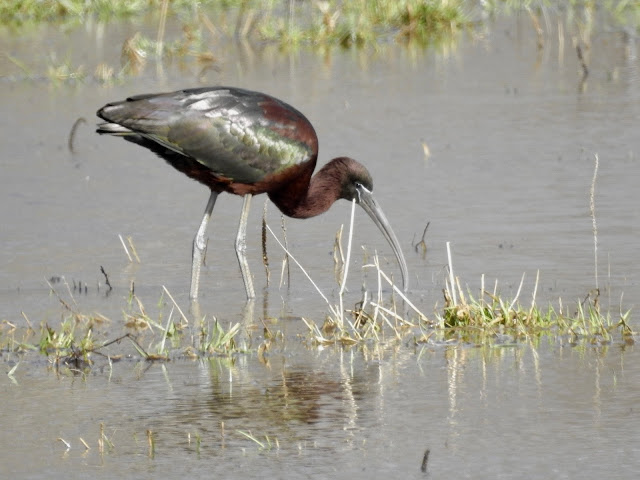Rare Wading Bird Visits Keswick
 |
| Glossy Ibis |
A tall wading bird has been visiting the Keswick area for the last 5 days. It is 58 cm long (23 in) and is very dark in colour. At a distance it looks black. Yesterday it was feeding with about 20 Ring-billed Gulls and 2 Black Ducks in flooded fields off Tripp Settlement Road.
The Glossy Ibis (Pleagadis falcinellus) is a rare 'vagrant' to this area. In ornithological parlance that means it is a species that wanders out of its normal range. Normally it is a permanent resident of Florida and the Gulf Coast. It moves northward in summer to breed as far north as occasionally southern Maine. It also is found in Eurasia, Southeast Asia, Pacific Islands, Africa, and Australia.
Before 1900 this species was extremely rare here. It gradually became more abundant as the twentieth century progressed. It is thought that the original birds accidentally appeared here from Africa in the 1800s (much like the Cattle Egret). There were a few sightings in Florida and the Caribbean Islands in the 1800s. There is an early breeding record from Orange Lake, Florida in 1913. We have records of a bird appearing in Pictou County, NS in 1856 and one in Montreal in 1900. The one in NS from 1856 is most likely a bird blown off course from Europe. The one from Montreal was likely a bird from the newly developing North American population. The first reports for New Brunswick were in the 1950s. The first one I ever saw was in the early 1960s at Saint Andrews.
 |
| Glossy Ibis |
The Glossy Ibis nests in trees and is pugnacious towards other birds. It drives away other ibises and herons that might be nesting near it. It is loving and attentive to its mate and offspring, often caressing them by bill rubbing, cooing and exercising mutual grooming. There are usually 3 or 4 offspring. They feed by probing the mud for crayfish, invertebrates, frogs, fish, and plants. In the south they eat a lot of snakes and are thought to assist in snake control. They have never bred here but there was one unsuccessful attempt on Manawagonish Island, off Saint John in 1986.
 |
| Glossy Ibis |
Like herons, ibises fly with their necks outstretched. Their decurved bills are often visible as they fly by. The Glossy Ibis is no songster. It utters a guttural screeching sound as well as its soft cooing to its mate.
As the photos show, this bird is beautiful. Its head and breast are a deep chestnut colour. The wings look black but actually are iridescent blue and green. The bill and legs are grey. The eye is black and there is a fine bluish white line around the bill base which does not extend around the eye. Both genders look alike. The young are mottled grayish in the head and neck. It is a species that needs to be distinguished from the White-faced Ibis which lives in western North America.
It is interesting that we usually get one or two individuals here every spring. This would indicate it is expanding its range. The bird shown in the photos above is an adult in breeding plumage. Hopefully it will find a mate and we will be able to record a successful breeding and raising of young for this year in New Brunswick.
No comments:
Post a Comment